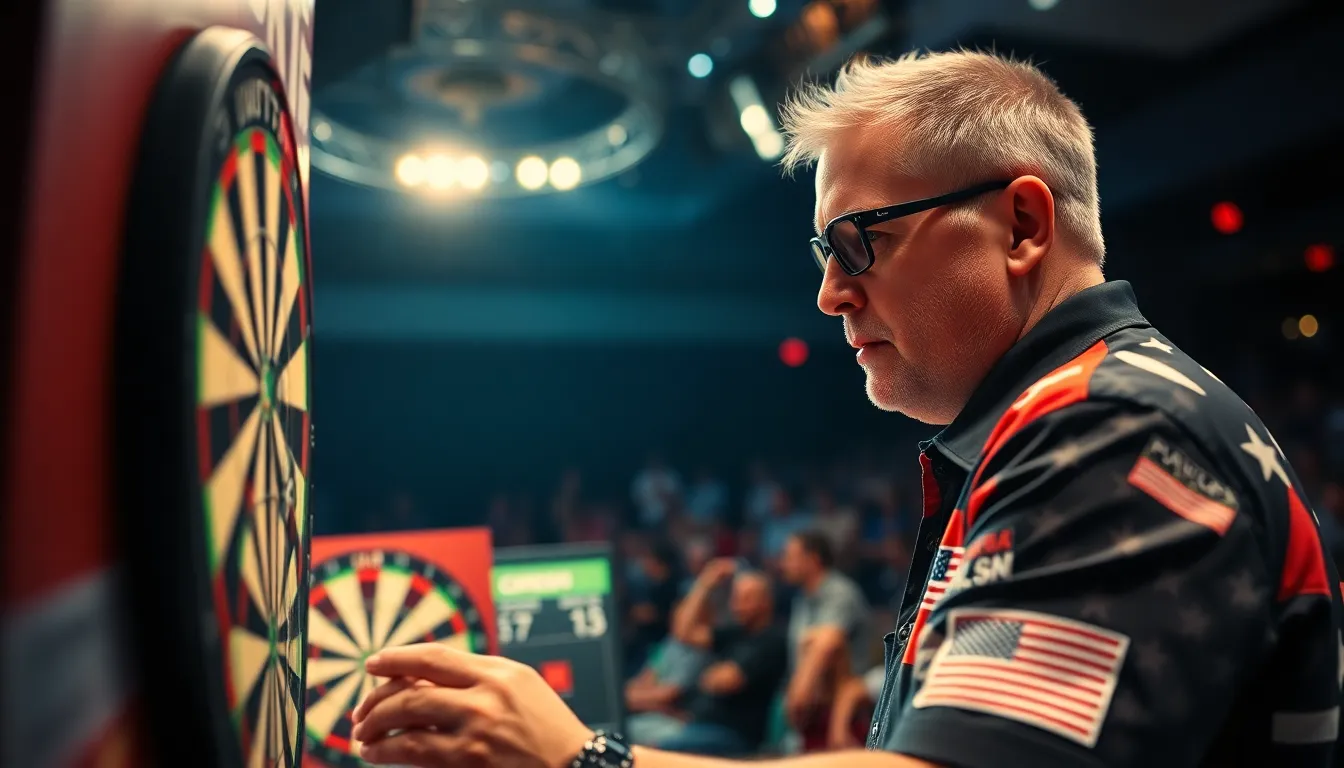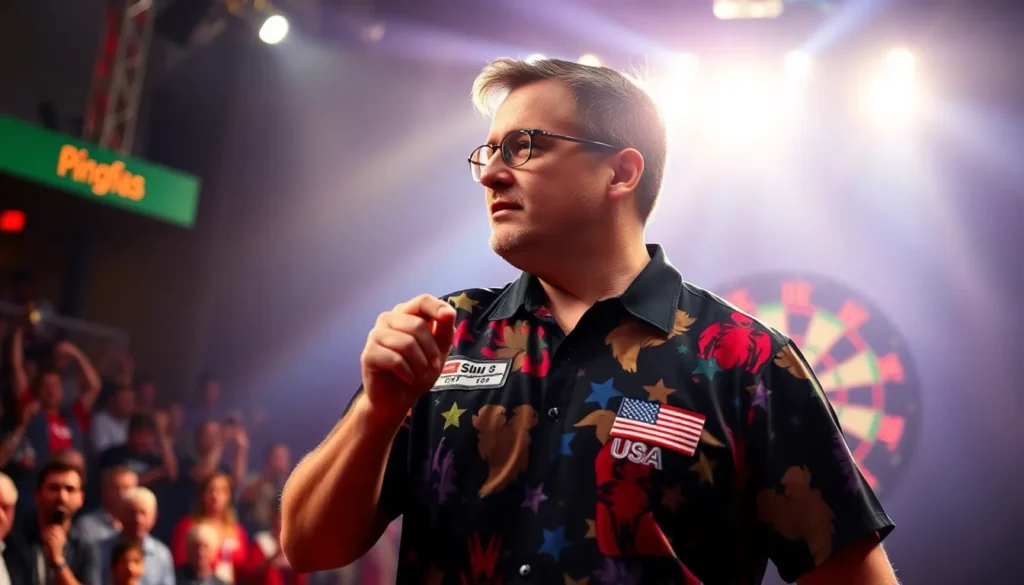Table of Contents
ToggleIn the electrifying world of darts, the final showdown isn’t just a game; it’s a spectacle packed with tension and drama. Fans gather, snacks in hand, ready to cheer as their favorites battle it out for glory. But how many sets are actually played in this ultimate clash? It’s a question that sparks curiosity and debate among enthusiasts and casual viewers alike.
Overview of Darts Finals
Darts finals showcase the pinnacle of competitive play, making them a highlight in the sport. Typically, tournaments like the PDC World Championship feature matches played in a best-of-sets format, intensifying the drama of the event. These finals consist of 13 sets in total, with the first player to secure seven sets declared the winner.
Players exhibit remarkable skill and strategy, captivating audiences throughout the duration of each match. Fans appreciate the pressure players face, as every throw influences the trajectory toward victory. Often, the intensity of the final reaches a crescendo as single sets determine the fate of the competitors. The engaging atmosphere amplifies this excitement, transforming the event into an unforgettable spectacle.
Crowd involvement significantly impacts the environment during the finals. Spectators cheer for their favorites, creating a palpable tension as players take their turns. This electric atmosphere enhances the experience, solidifying darts finals as the sport’s grandest stage.
In terms of scoring, each set requires players to win by two legs. The first to reach three legs in a set secures that set. Adopting this structure ensures that both skill and consistency play a crucial role in determining the champion. As players advance through the rounds, their mental fortitude becomes essential, amplifying audience engagement.
Excitement builds with each set, illustrating why darts draws such a fervent following globally. The criteria and format of the finals contribute to the competitive spirit, demonstrating the sport’s complexity and allure.
Types of Darts Competitions

Darts competitions come in various formats, each contributing to the sport’s excitement. Each format serves a unique purpose, shaping the dynamics of the matches.
Best of Sets Format
The best of sets format is prevalent in major tournaments, including the PDC World Championship. In this setup, the match occurs over a predetermined number of sets, typically 13. A player must win seven sets to clinch victory, creating a high-stakes environment where every throw counts. Each set comprises legs, with players needing to secure three legs to win a set. This structure emphasizes not only skill but also endurance and strategy, as players must maintain focus throughout the match. The thrill lies in the pressure, as a single set can turn the tide of the competition.
Single Elimination Format
The single elimination format offers a different kind of intensity. In this approach, players face off in knockout rounds, where one loss eliminates them from the tournament. Competition heightens as every match determines survival in the event. Typically, the last player standing becomes the champion. This format can create dramatic moments, as each game demands peak performance and resolve. Players often experience both excitement and tension, knowing that any mistake could lead to their exit from the contest. The single elimination structure ensures that stakes remain high throughout the tournament.
How Many Sets in the Darts Final
Darts finals are often structured in an exciting best-of-sets format. This format typically includes 13 sets, where the first player to win seven sets emerges victorious.
Historical Context
Darts has evolved significantly since its early days. Initially, matches lacked a standard set structure. Over time, the introduction of the best-of-sets format became common, particularly in prestigious tournaments like the PDC World Championship. Historical changes shaped the tournament landscape, enhancing competitive play and audience engagement. The rise of televised matches further solidified darts as a mainstream sport, drawing larger crowds and fostering a deeper appreciation for the game.
Current Format and Regulations
Currently, the PDC World Championship follows established regulations for its finals. Each set consists of players competing to win two legs. A leg is won by the first player to reach three legs, creating a tense atmosphere. Matches involve not just skill but also strategy, with players needing to adapt effectively during gameplay. Regulations ensure that the competition remains fair and exciting, allowing players to showcase their talent under pressure.
Impact of Sets on Game Strategy
Sets play a critical role in shaping game strategy during darts finals. Players must develop a strategic approach for each set to secure a victory. Winning seven sets in a best-of-sets matchup, such as in the PDC World Championship, requires meticulous planning and execution. Focusing on winning three legs can influence players’ tactics, as each leg contributes to the overall set.
Every throw carries significant weight, influencing not only the current leg but the momentum of the entire match. Players often adapt their strategies based on their opponent’s performance within a set. Adjusting tactics mid-game allows for overcoming challenges and exploiting weaknesses. Use of various darts techniques, such as aiming for triple segments, showcases players’ adaptability and skill under pressure.
A player’s mental fortitude becomes increasingly essential as the number of sets progresses. Each set adds to the stress of competition, impacting focus and decision-making. Fans witness the intensity of competition escalate as players vie for each critical moment. Crowd engagement amplifies this effect, with cheers potentially swaying a player’s performance.
Additionally, historical changes in the format have also influenced game strategy. The adoption of the best-of-sets format transformed how seniors strategize during finals. TV coverage highlighted the sophistication of play, captivating a broader audience and rationalizing the need for in-depth strategies. Competitive structures have evolved to accommodate advanced techniques and psychological tactics, solidifying the sport’s status on the global stage.
Thus, understanding the impact of sets drives appreciation of darts as a strategic sport. Observing how players navigate these challenges reveals the layered complexity of each match. In essence, every decision and tactic intertwines within the framework of sets, making this an enthralling spectacle for fans and participants alike.
The darts final stands as a testament to the sport’s thrilling nature and strategic depth. With 13 sets in play the stakes are high and every throw matters. Players must navigate not just their skills but also the pressure of the crowd and the weight of expectations.
This unique format enhances the drama and excitement that fans crave. As players battle for supremacy the evolution of the game continues to captivate audiences worldwide. Understanding the significance of sets in this context deepens appreciation for darts as more than just a game but as a showcase of talent and resilience.



